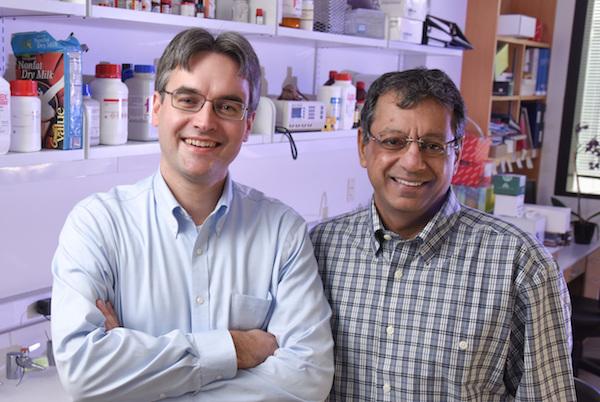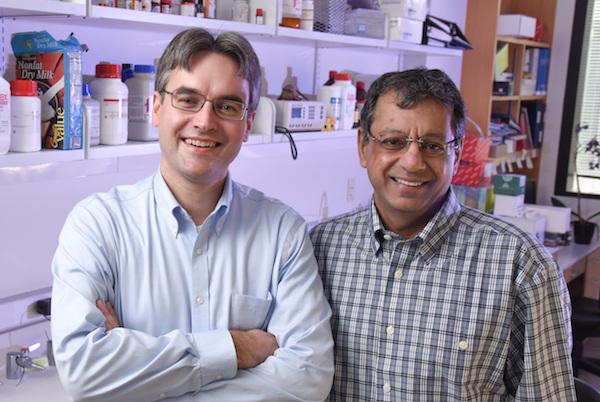
Credit: UT Southwestern Medical Center
DALLAS – January 24, 2017 – Scientists have found a way to inhibit the growth of glioblastoma, a type of brain cancer with low survival rates, by targeting a protein that drives growth of brain tumors, according to research from the Peter O'Donnell Jr. Brain Institute and Harold C. Simmons Comprehensive Cancer Center.
"These findings change our fundamental understanding of the molecular basis of glioblastoma, and how to treat it," said co-senior author Dr. Robert Bachoo, Associate Professor of Neurology and Neurotherapeutics, Internal Medicine, and with the Annette G. Strauss Center for Neuro-Oncology at UT Southwestern Medical Center. "We may have identified a set of critical genes we can target with drugs that are shared across nearly all glioblastomas."
The study, published in Cell Reports, represents research from UT Southwestern's precision medicine campaign in neuro-oncology.
For the past decade, patients diagnosed with glioblastoma have been treated with the current standard of care regimen: surgery followed by chemotherapy and radiation. This regimen improves median survival by an average of four to six months, followed by recurrence of the tumor. There are currently no successful therapies available to treat glioblastoma patients when the tumor recurs. Five-year survival rates are around 5 percent.
Faced with these prospects, the brain tumor research and clinical communities turned to genetic studies to guide possible treatment strategies.
"Our work shows that the gene mutations which the pharmaceutical industry and clinicians have been focusing on are essential only for starting tumor growth. Once the tumor has advanced to the stage where patients seek treatment, these mutations are no longer required for continued tumor growth; they are in effect redundant," said Dr. Bachoo, a member of the Simmons Cancer Center and O'Donnell Brain Institute, who holds the Miller Family Professorship in Neuro?Oncology. Previously, proteins called receptor tyrosine kinase were considered the drivers of glioblastoma; however, drugs that inhibit these proteins have not been effective in treating this type of cancer.
"We learned that, instead, it is neurodevelopmental transcription factors (master proteins that regulate the activity of hundreds of genes during normal brain development), which are reactivated to drive the growth of glioblastoma. We can inhibit these transcription factors and prevent further tumor growth with the chemotherapy drug mithramycin, a drug that has not been in clinical use for years due to its side effects," said co-senior author Dr. Ralf Kittler, Assistant Professor of Pharmacology in the Eugene McDermott Center for Human Growth and Development. "Our discovery has the potential for the development of a new therapy that may increase survival time for glioblastoma patients."
. Kittler, a member of the Simmons Cancer Center and the Cecil H. and Ida Green Center for Reproductive Biology Sciences, is a Cancer Prevention and Research Institute of Texas (CPRIT) Scholar in Cancer Research and John L. Roach Scholar in Biomedical Research.
The researchers caution that repurposing mithramycin, which is known to cause liver toxicity in some patients, with safer and more effective treatments for brain tumor patients may take years.
###
This study was supported by National Institutes of Health, the Cancer Prevention and Research Institute of Texas, the Annette G. Strauss Center for Neuro-Oncology, the William Conley and Family Fund, the Miller Family Fund in Neuro-oncology, and the Beth Kahn Wings and Roots Foundation.
Contributing authors include Dr. Bruce Mickey, Professor of Neurological Surgery, Otolaryngology – Head and Neck Surgery, and Radiation Oncology, who holds the William Kemp Clark Chair of Neurological Surgery; and Dr. Elizabeth Maher, Associate Professor of Internal Medicine, and Neurology and Neurotherapeutics, who holds the Theodore H. Strauss Professorship in Neuro?Oncology. Both are members of the Simmons Cancer Center, the Peter O'Donnell Jr. Brain Institute, and the Annette G. Strauss Center for Neuro-Oncology.
Other UT Southwestern researchers included co-lead author Rahul K. Kollipara, computational biologist; Vamsidara Vemireddy, research associate; Yuxiao Sun, research scientist; Nanda Regmi, research scientist; Dr. Kimmo J. Hatanpaa, Associate Professor of Pathology; Dr. Jack Raisanen, Professor of Pathology; Shyam Sirasanagandla, senior research associate; Tomoyuki Mashimo, research coordinator; Dr. Shan Wang, Instructor of Urology; and Caroline G. Humphries, senior research scientist. Additional researchers included co-lead author Dinesh K. Singh, a former UT Southwestern researcher now with the CSIR Indian Institute of Toxicology; researchers from the Albert Einstein Cancer Center and Cold Spring Harbor Laboratory; and former UT Southwestern researchers Xiao-Li Yang, Steve K. Cho, Suraj Nannepaga, and Sara Piccirillo.
About UT Southwestern Medical Center
UT Southwestern, one of the premier academic medical centers in the nation, integrates pioneering biomedical research with exceptional clinical care and education. The institution's faculty includes many distinguished members, including six who have been awarded Nobel Prizes since 1985. The faculty of almost 2,800 is responsible for groundbreaking medical advances and is committed to translating science-driven research quickly to new clinical treatments. UT Southwestern physicians provide medical care in about 80 specialties to more than 100,000 hospitalized patients and oversee approximately 2.2 million outpatient visits a year.
Media Contact
Lori Sundeen Soderbergh
[email protected]
214-648-3404
@UTSWNews
http://www.swmed.edu
############
Story Source: Materials provided by Scienmag




